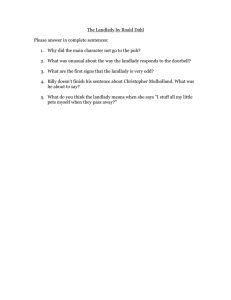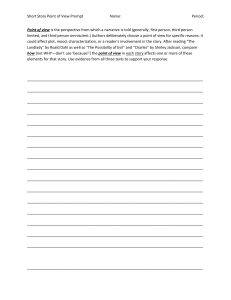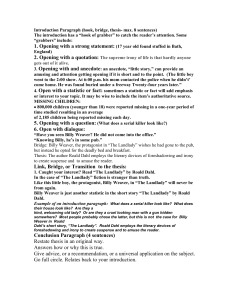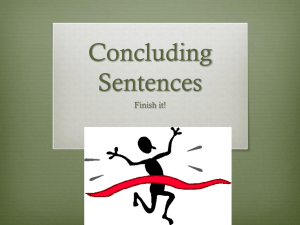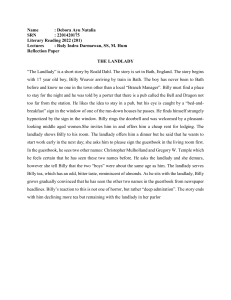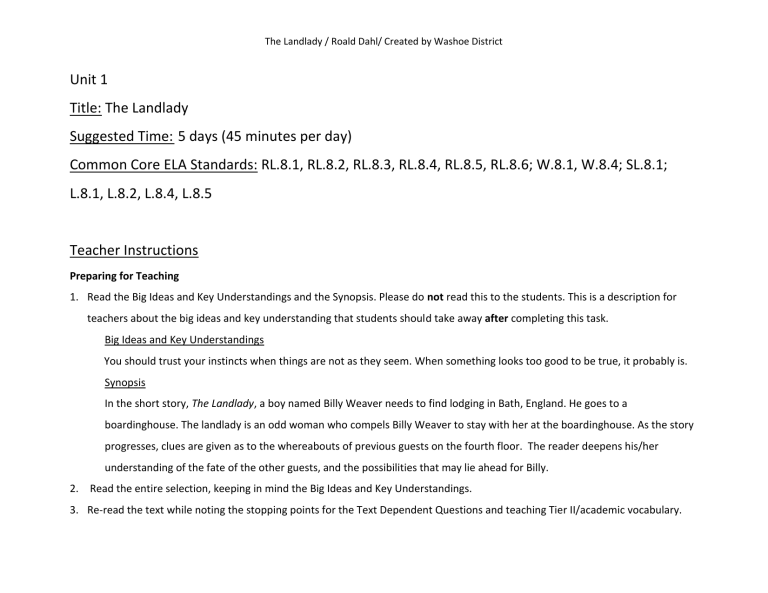
The Landlady / Roald Dahl/ Created by Washoe District Unit 1 Title: The Landlady Suggested Time: 5 days (45 minutes per day) Common Core ELA Standards: RL.8.1, RL.8.2, RL.8.3, RL.8.4, RL.8.5, RL.8.6; W.8.1, W.8.4; SL.8.1; L.8.1, L.8.2, L.8.4, L.8.5 Teacher Instructions Preparing for Teaching 1. Read the Big Ideas and Key Understandings and the Synopsis. Please do not read this to the students. This is a description for teachers about the big ideas and key understanding that students should take away after completing this task. Big Ideas and Key Understandings You should trust your instincts when things are not as they seem. When something looks too good to be true, it probably is. Synopsis In the short story, The Landlady, a boy named Billy Weaver needs to find lodging in Bath, England. He goes to a boardinghouse. The landlady is an odd woman who compels Billy Weaver to stay with her at the boardinghouse. As the story progresses, clues are given as to the whereabouts of previous guests on the fourth floor. The reader deepens his/her understanding of the fate of the other guests, and the possibilities that may lie ahead for Billy. 2. Read the entire selection, keeping in mind the Big Ideas and Key Understandings. 3. Re-read the text while noting the stopping points for the Text Dependent Questions and teaching Tier II/academic vocabulary. The Landlady / Roald Dahl/ Created by Washoe District During Teaching 1. Students read the entire selection independently. 2. Teacher reads the text aloud while students follow along or students take turns reading aloud to each other. Depending on the text length and student need, the teacher may choose to read the full text or a passage aloud. For a particularly complex text, the teacher may choose to reverse the order of steps 1 and 2. 3. Students and teacher re-read the text while stopping to respond to and discuss the questions, continually returning to the text. A variety of methods can be used to structure the reading and discussion (i.e., whole class discussion, think-pair-share, independent written response, group work, etc.) Text Dependent Questions Text-dependent Questions On page 73, the author uses the words: brisk, briskly, and briskness in the first full paragraph. Billy states that, "briskness is a common characteristic of all successful businessmen." What does the author mean by this word and what is the significance of being "brisk" in the story? When Billy arrives in the city of Bath, the first thing he needs to do is find lodgings. Why is he debating between staying at pub instead of a boardinghouse? Reread the paragraph on page 73, that begins, “Suddenly, in a downstairs window…” and continue rereading through the next few paragraphs. What words and phrases does the author use to describe the Bed and Breakfast? What inference does Billy Evidence-based Answers The author uses brisk four times in all its forms to indicate the kind of quick, efficient, skipping quality of no-nonsense that a young kid trying to fit into the business world would notice. The Pub would be more fun for him as a young man than the boarding house. At the pub there would be beer and darts in the evenings, lots of people to talk to, and it would probably be a good bit cheaper. But, this boardinghouse however, had pleasant furniture, and animals which were usually a good sign and he thought it would be a pretty decent house to stay in. “beautiful, wonderful chrysanthemums,” “bright burning fire in the hearth,” “pretty little dachshund curled up,” “pleasant furniture,” “plump armchairs,” “animals were usually a good sign in a place like this” The Landlady / Roald Dahl/ Created by Washoe District make about the Bed and Breakfast based on these observations? “All in all, it looked to him as though it would be a pretty decent house to stay in. Certainly it would be more comfortable than The Bell and Dragon.” On page 74, the author says that Billy turns to go, “and now a queer thing happened to him.” Summarize what happens in this scene. How does the author describe the sign and Billy’s reaction? The author says that “…his eye was caught and held in the most peculiar manner by the small notice. BED AND BREAKFAST in capital letters was repeated four times.” "Each word was like a large black eye staring at him through the glass holding him, compelling him, forcing him to stay...and not to walk away from the house..." The author includes this information to inform the reader that Billy was compelled to choose this location; he seemed to have little control. The reader understands that Billy's original thoughts may be warranted and to hint at possible strangeness and outcomes of the story. Queer, peculiar, black eye, compelling and forcing are words used to alert Billy. She is up to something. Is she magical or sinister? She could not have known Billy was coming. Billy senses something strange. Which words in paragraph 2, page 74, suggest that Billy should be on the alert? The narrator emphasises the speed at which the Landlady answers the door. What might this foreshadow about the landlady, about Billy, and about how the two might interact later in the story? Reread the paragraph in the second column on page 74 that begins, “Please come in.” What words or phrases does the author use to describe what happens next and how Billy feels about the situation? Should he have been suspicious at this point in the story? Why or why not? Use evidence from the text in your response. “Billy found himself automatically starting forward. The compulsion or, more accurately, the desire to follow after her into that house was extraordinarily strong.” This strong desire to follow her into “that” house should have alerted him that something might not be quite right. Especially since moments before the sign compelled him to stay. It was also strange that she answered the door before he even took his finger off of the bell, even though he heard the bell ringing far away in a back room. The landlady says the room is “all ready” for him even though he is just “wondering” about a room. The Landlady / Roald Dahl/ Created by Washoe District How does the author’s use of irony when describing the landlady make the reader question her? On page 75, in paragraph 10, why does the author include the line, "There were no other hats or coats in the hall. There were no umbrellas, no walking sticks-nothing."? When Billy is in the living room, what first alerts the reader that something may be wrong? As Billy is almost remembering the connection between the two boys, what effect did the interruptions from the landlady have on the story? What can the reader infer, using evidence from the text, about the two boys that are missing? What does this information lead the reader to believe concerning Billy's possible fate? What other evidence from the story suggests a possible, fatal demise for Billy? He uses phrases such as terribly nice, the old girl is slightly dotty, inclined to be a teeny weeny tiny bit particular, slightly of her rocker. The author supplies the reader with information to hint at why there are no other guests. Billy signs the guest book and sees two names he recognizes, maybe from newspaper headlines. He is almost positive he has heard of them before. There is no evidence in the house of other occupants. The reader wonders, where they are and where they have gone. She interrupts him which builds suspense and distracts him. The landlady describes the boys in detail: “trifle shorter than you, teeth weren’t as white, wasn’t a blemish on his body, skin was like a baby’s.” At this point in the story we have no evidence that Billy suspects his fate, but the reader may be wondering if Billy might be stuffed when she says that, “...I stuff all my little pets myself when they pass away. Will you have another cup of tea?” The landlady also “looked up at him out of the corner of her eyes and gave him another gentle little smile” when she said her only other guests were Billy. Some possible examples would be the "stuffed" animals in the living room, the suspicious smell of the tea the landlady served, etc. The Landlady / Roald Dahl/ Created by Washoe District Tier II/Academic Vocabulary Meaning can be learned from context These words require more time to learn (They are abstract, have multiple meanings, are a part of a word family, or are likely to appear again in future texts) Page 73 - dotty, illuminated, blotchy, hearth, splendid, facades Page 75 - earnestly, threshold Page 79 - blemish, puzzling Meaning needs to be provided These words require less time to learn (They are concrete or describe an object/event/ process/characteristic that is familiar to students) Page 73 - congenial, rapacious, lapsed Page 74 - queer, peculiar Page 76 - proceedings Page 76 - frisky Page 77 - dainty Page 73 - applicant Page 74 - compelling, compulsion Page 76 - swamped Page 78 - lingers Page 79 - trifle Page 73 - conjured Page 73 - brisk, briskness, briskly Page 81 - tantalizing Page 79 - preserved, emanate The Landlady / Roald Dahl/ Created by Washoe District Culminating Writing Task Prompt The Landlady is a chilling tale that teaches the reader that when something looks too good to be true, it probably is. Provide examples from the text that demonstrate how Roald Dahl creates suspense and a sense of foreboding as he drives the reader to discover the moral of this tale. Teacher Instructions 1. Students identify their writing task from the prompt provided. 2. Students complete an evidence chart as a pre-writing activity. Teachers should remind students to use any relevant notes they compiled while reading and answering the text-dependent questions. Evidence Quote or paraphrase “The air was deadly cold and the wind like a flat blade of ice against his cheeks.” Page number 72 74 Elaboration / explanation of how this evidence supports ideas or argument This foreshadowing sets up the reader to be on guard for future peculiar happenings (develops the rising action). Something about this sign is ominous. “Forcing him,” alludes to the fact that he doesn't seem to have a choice, but is being driven to the house. She is ready to pounce on her victim. A queer thing happened. "Each word was like a large, black eye staring at him through the glass, ... holding him, compelling him, forcing him..." The dame was like a jack in the box, she refers to her "nest". No other coats or hats in the hall... 74 75 No evidence of any other living person around. I see someone standing there who is just exactly right. 75 She has a certain profile for her victims. “You see, it isn't very often that I have the pleasure of taking a visitor into my little nest. 75 The words, little nest, compare her to an insect, a wasp or spider. The Landlady / Roald Dahl/ Created by Washoe District She is slightly dotty. 75 The author is revealing bits and pieces of her character that assist the reader to become suspicious of the landlady. “Everyone has to do that because it's the law of the land and we don't want to go breaking any laws at this stage in the proceedings do we?” 76 This quote suggests that she will be breaking the law at some point. 3. Once students have completed the evidence chart, they should look back at the writing prompt in order to remind themselves what kind of response they are writing (i.e. expository, analytical, argumentative) and think about the evidence they found. (Depending on the grade level, teachers may want to review students’ evidence charts in some way to ensure accuracy.) From here, students should develop a specific thesis statement. This could be done independently, with a partner, small group, or the entire class. Consider directing students to the following sites to learn more about thesis statements: http://owl.english.purdue.edu/owl/resource/545/01/ OR http://www.indiana.edu/~wts/pamphlets/ thesis_statement.shtml. 4. Students compose a rough draft. With regard to grade level and student ability, teachers should decide how much scaffolding they will provide during this process (i.e. modeling, showing example pieces, sharing work as students go). 5. Students complete final draft. Sample Answer In the short story, The Landlady, Roald Dahl creates a masterful example of how to create a story which is filled with suspense and foreboding. At every turn, Dahl places clues which lead the reader further on the path of his twisted tale to the conclusion that the landlady is someone who should not be trusted. His adept descriptions of his characters and setting, his use of language and a wellstructured plot all help lead the reader to an unsettling conclusion. The Landlady / Roald Dahl/ Created by Washoe District Dahl opens the story with the description of the young, idyllic Billy, traveling to Bath for work. At the onset, he describes Billy as wanting to do everything briskly, like all successful business men. He places us in Billy’s mind as he considers where to take lodgings, a congenial pub or a boarding house that would potentially have peculiar smells. Naïve Billy ignores his intuition and investigates the boarding house, seemingly drawn there. Similarly, Dahl gives clues to the reader about his landlady character as he describes her as “slightly dotty” and states that she springs to open the door when the bell has rung like a “jack in the box.” She is ready to pounce on her victim. Equally, Dahl creates suspense as he describes the boarding house in various parts of the story. He begins with describing the sign in the window that compels Billy forward towards the house, “Each word was like a large black eye staring at him through the glass, ... holding him, compelling him, forcing him." Something about this sign is ominous. “Forcing him,” alludes to the fact that he doesn't have a choice but to be driven to the house. As Billy looks through the window, he sees a bird and a dog curled up by the warm hearth. Later in the story when Billy enters that room, he finds the animals in the same position… because they have been stuffed, a clue to the whereabouts of previous guests. Furthermore, Dahl intentionally uses descriptive language throughout the story to also create tension in the reader’s mind. As he begins the story he states, “The air was deadly cold and the wind like a flat blade of ice against his cheeks.” Deadly cold and flat blade cleverly implies death has either happened or will soon occur. Another example, “You see, it isn't very often that I have the pleasure of taking a visitor into my little nest.” The words “little nest” compare her to an insect, a wasp, or spider awaiting her next victim. Additionally, the statement, “Everyone has to do that because it's the law of the land and we don't want to go breaking any laws at this stage in the proceedings do we?” suggests that the Landlady has broken the law before. Finally, the way in which the plot is structured builds tension for the reader as he gets deeper into the story. Billy, curiously being drawn to the boarding house, the absences of other’s belongings such as hats, coats and umbrellas in the front receiving room, only two names in the guest registry that seem somehow familiar, and the discovery that the charming pets are not live creatures, but The Landlady / Roald Dahl/ Created by Washoe District stuffed representations of their former selves, are all ways Dahl leads the reader through the story to the conclusion that everything is not as it first appeared, and Billy should definitely be concerned for his life. The odd smell of the tea is Dahl’s final gift to the reader. Powerfully crafting this story, Dahl through his intentional use of description, interesting language, and plot development compel the reader to interact with his story on an emotional level which heightens the reader’s experience and creates tension in the reader’s mind. Dahl leaves the reader with the feeling that one should always beware of daunting, old boarding houses and sinister old ladies. Additional Tasks Read this passage from The Twits by Roald Dahl and compare and contrast the theme, development, word choice, character development, and/or structure, etc. with that of The Landlady. "If a person has ugly thoughts, it begins to show on the face. And when that person has ugly thoughts every day, every week, every year, the face gets uglier and uglier until it looks so ugly you can hardly bear to look at it." How do you outwit a Twit? Mr. and Mrs. Twit are the smelliest, ugliest people in the world. They hate everything -- except playing mean jokes on each other, catching innocent birds to put in their Bird Pies, and making their caged monkeys, the Muggle-Wumps, stand on their heads all day. But the Muggle-Wumps have had enough. They don't just want out, they want revenge. Answer: Roald Dahl is a master, a coinsurer of words. When you look at both passages which describe his characters, you notice this element of careful word choice and how it helps to build a picture in the reader’s mind. Both in The Landlady and The Twit, he describes the characters as eerily peculiar and strange. The Landlady / Roald Dahl/ Created by Washoe District If Billy was to live through his visit to the Bed and Breakfast what advice would he give to other young executives? Write a blog post that describes why executives would want to avoid staying at the Bed and Breakfast in Bath, England. Use evidence from the text in your blog post. Answer Dear Fellow Travelers, Beware of deceiving old landladies, especially those found at the Bed and Breakfast in Bath, England! Although they may appear sweet and rather gentile, you never know what lurks behind that archaic smile and glint in their eye. I myself had the misfortune of meeting such a vixen! I was traveling to Bath for work and was searching for lodgings when I came across this seemingly quaint, cozy boarding house. Although, something was telling me to turn and find the nearest pub, I did not listen to my instincts and approached the house. From the second that the landlady jolted open the door I started to feel as though something was just not right with the old dame. She spoke of expecting me, and that I was just the right size? Why, oh why, did I not take those clues under consideration and run the other direction. As the evening unfolded and I saw no evidence of any other house guests about, I considered my options. When I walked into the drawing room and the animals were all stuffed I decided I had better high-tail it out of there. I made some excuse about meeting up with some friends that were expecting me at the pub and narrowly escaped with my life before she could coax me into drinking her queerly, smelling tea. Friends, you have been warned, Billy The Landlady / Roald Dahl/ Created by Washoe District Name ____________________________________________ Date _________________ “The Landlady” 1. On page 73, the author uses the words: brisk, briskly, and briskness in the first full paragraph. Billy states that, "briskness is a common characteristic of all successful businessmen." What does the author mean by this word and what is the significance of being "brisk" in the story? 2. When Billy arrives in the city of Bath, the first thing he needs to do is find lodgings. Why is he debating between staying at pub instead of a boardinghouse? 3. Reread the paragraph on page 73, that begins, “Suddenly, in a downstairs window…” and continue rereading through the next few paragraphs. What words and phrases does the author use to describe the Bed and Breakfast? What inference does Billy make about the Bed and Breakfast based on these observations? 4. On page 74, the author says that Billy turns to go, “and now a queer thing happened to him.” Summarize what happens in this scene. How does the author describe the sign and Billy’s reaction? The Landlady / Roald Dahl/ Created by Washoe District 5. Which words in paragraph 2, page 74, suggest that Billy should be on the alert? 6. The narrator emphasises the speed at which the Landlady answers the door. What might this foreshadow about the landlady, about Billy, and about how the two might interact later in the story? 7. Reread the paragraph in the second column on page 74 that begins, “Please come in.” What words or phrases does the author use to describe what happens next and how Billy feels about the situation? Should he have been suspicious at this point in the story? Why or why not? Use evidence from the text in your response. 8. How does the author’s use of irony when describing the landlady make the reader question her? The Landlady / Roald Dahl/ Created by Washoe District 9. On page 75, in paragraph 10, why does the author include the line, "There were no other hats or coats in the hall. There were no umbrellas, no walking sticks-nothing."? 10. When Billy is in the living room, what first alerts the reader that something may be wrong? 11. As Billy is almost remembering the connection between the two boys, what effect did the interruptions from the landlady have on the story? 12. What can the reader infer, using evidence from the text, about the two boys that are missing? What does this information lead the reader to believe concerning Billy's possible fate? 13. What other evidence from the story suggests a possible, fatal demise for Billy? The Landlady / Roald Dahl/ Created by Washoe District Supports for English Language Learners (ELLs) to use with Anthology Alignment Lessons When teaching any lesson, it is important to make sure you are including supports to help all students. We have prepared some examples of different types of supports that you can use in conjunction with our Anthology Alignment Lessons to ensure ELLs can engage fully with the lesson. While these supports reflect research in how to support ELLs, these activities can help ALL students engage more deeply with these lessons. Note that some strategies should be used at multiple points within a lesson; we’ll point these out. It is also important to understand that these scaffolds represent options for teachers to select based on students’ needs; it is not the intention that teachers should do all of these things at every lesson. Before reading: Read passages, watch videos, view photographs, discuss topics (e.g., using the four corners strategy), or research topics that help provide context for what your students will be reading. This is especially true if the setting (e.g., 18th Century England) or topic (e.g., boats) is one that is unfamiliar to the students. Provide explicit instruction, using multiple modalities, on selected vocabulary words that are central to understanding the text. When looking at the lesson plan, you should note the Tier 2 words, particularly those words with high conceptual complexity (i.e., they are difficult to visualize, learn from context clues, and are abstract), and consider introducing them ahead of reading. For more information on selecting such words, go here. You should plan to continue to reinforce these words, and additional vocabulary, in the context of reading and working with the text. (See additional activities in the During Reading and After Reading sections.) Examples of Activities: o Provide students with the definition of the words and then have students work together to create Frayer models or other kinds of word maps for the words. o When a word contains a prefix or suffix that has been introduced before, highlight how the word part can be used to help determine word meaning. o Keep a word wall or word bank where these new words can be added and that students can access later. o Have students create visual glossaries for whenever they encounter new words. Then have your students add these words to their visual glossaries. o Create pictures using the word. These can even be added to your word wall! o Create lists of synonyms and antonyms for the word. o Have students practice using the words in conversation. For newcomers, consider providing them with sentence frames to ensure they can participate in the conversation. Use graphic organizers to help introduce content. The Landlady / Roald Dahl/ Created by Washoe District Examples of Activities: o Complete a Know, Want to Learn, Learned (KWL) graphic organizer about the text. o Have students research the setting or topic and fill in a chart about it. You could even have students work in groups where each group is assigned part of the topic. o Fill in a bubble map where they write down anything that they find interesting about the topic while watching a video or reading a passage about the topic. Then students can discuss why they picked the information. During reading: Allow ELLs to collaborate in their home languages to process content before participating in whole class discussions in English. Consider giving them the discussion questions to look over in advance (perhaps during the first read) and having them work with a partner to prepare. Allow ELLs to use English language that is still under development. Students should not be scored lower because of incorrect spelling or grammar (unless the goal of the assignment is to assess spelling or grammar skills specifically). When grading, be sure to focus on scoring your students only for that objective. Scaffold questions for discussions so that questioning sequences include a mix of factual and inferential questions and a mix of shorter and more extended responses. Questions should build on each other and toward inferential and higher order thinking questions. There are not many factual questions already listed in the lesson instructions, so you will need to build some in as you see fit. More information on this strategy can be found here. Provide explicit instruction, using multiple modalities, on selected vocabulary words (e.g., 5–8 for a given text) that are central to understanding the text. During reading, you should continue to draw attention to and discuss the words that you taught before the reading. Examples of Activities: o Have students include the example from the text in a student-created glossary. o Create pictures that represent how the word was used in the passage. o Create sentences using the word in the way it was used in the passage. o Have students discuss the author’s word choice. o Examine important sentences in the text that contribute to the overall meaning of the text. Examine sentence structure of a particular sentence. Break down the sentence to determine its meaning. Then determine how this sentence contributes to the overall meaning of the passage. Determine if there is any figurative language in the sentence and have students use context clues to determine the meaning of the figurative language. The Landlady / Roald Dahl/ Created by Washoe District Use graphic organizers to help organize content and thinking. Examples of Activities: o While reading the text, have students fill in a story map to help summarize what has happened. o Have students fill in an evidence chart while they read to use with the culminating writing activity. Make sure to model with the students how to fill in the evidence chart by filling in the first couple of rows together as a class. Go over the prompt that the evidence should support, making sure to break down what the prompt means before having the students get to work. If some of your students frequently struggle to understand directions, have the students explain the directions back to you. o Provide somewhere for students to store new words that they encounter. Students could use a chart to keep track of these new words and their meanings as they read. o If you had students start a KWL before reading, have them fill in the “L” section as they read the passage. After reading: Reinforce new vocabulary using multiple modalities. Examples of activities: o Using the words that you had students work with before the reading, require students to include the words in the culminating writing task. o Create Frayer models with the words. Then cut up the Frayer models and have the students put the Frayer models back together by matching the pieces for each word. After reading the passage, continue to examine important sentences (1–2) in the text that contribute to the overall meaning of the text. Guide students to break apart these sentences, analyze different elements, and determine meaning. More information on how to do this, including models of sentence deconstruction, can be found here. When completing the writing assignments after reading, consider using these scaffolds to support students depending on their English proficiency. Examples of Activities: o For all students, go over the prompt in detail making sure to break down what the prompt means before having the students get to work. Then have the students explain the directions back to you. o Have students create an evidence tracking chart during reading, then direct them to look back over their evidence chart and work with a group to see if their evidence matches what the rest of the class wrote down. If some of the chart does not match, students should have a discussion about why. o For students who need more support, model the proper writing format for your students and provide them with a properly formatted example for reference. o For newcomers, you may consider creating sentence or paragraph frames to help them to write out their ideas.
